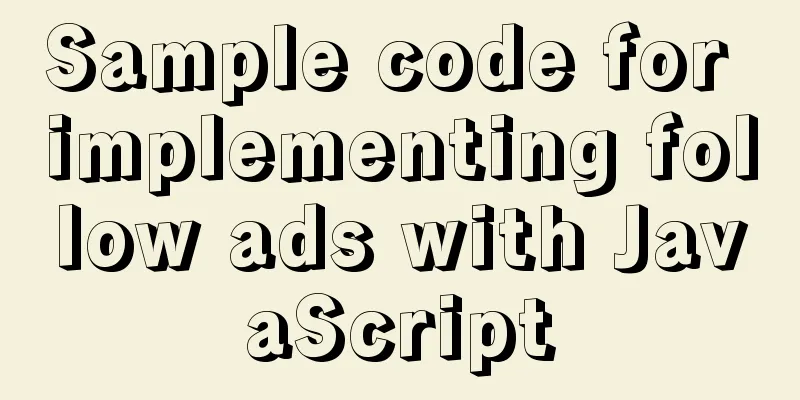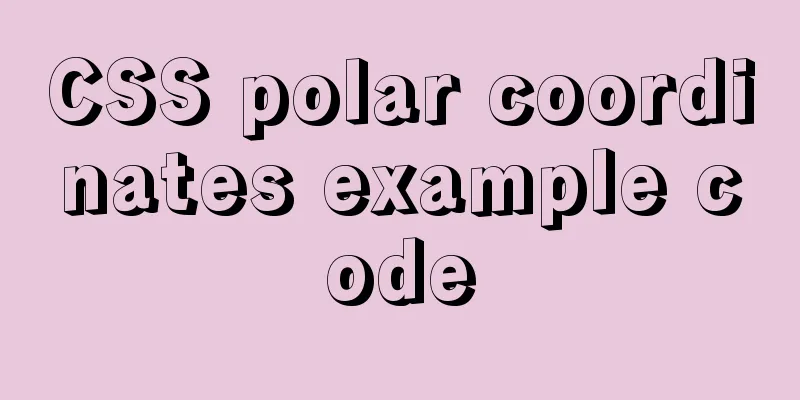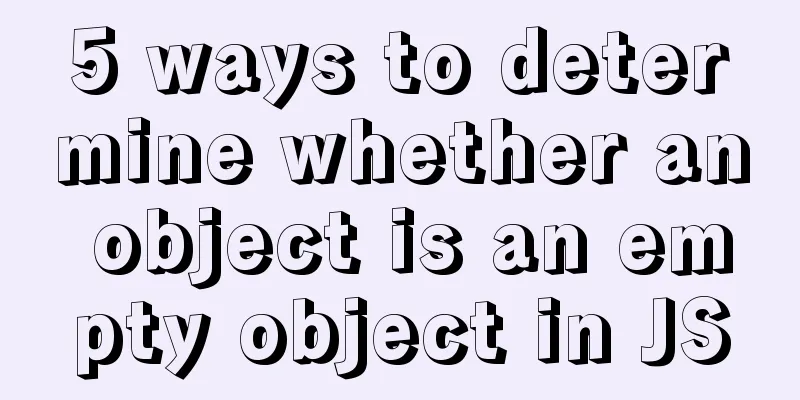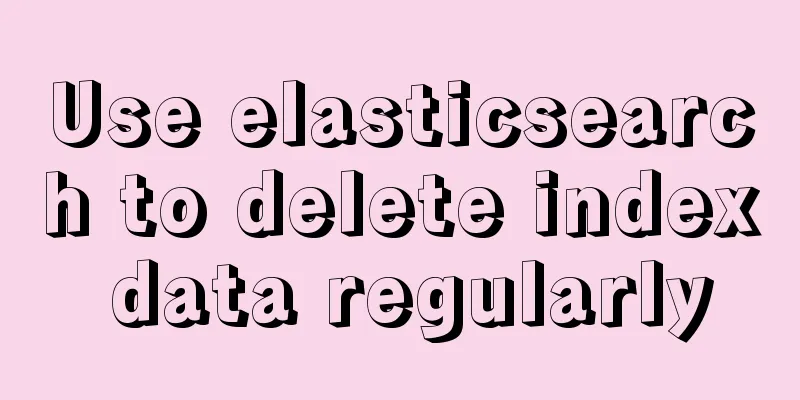Sample code for implementing follow ads with JavaScript

|
Floating ads are a very common form of advertising on websites. Floating ads can follow the user's browsing in real time, effectively convey the meaning of the product, and achieve good communication effects. So how are floating ads implemented? In fact, it is not difficult to implement floating ads. The details are as follows:
* {
margin: 0;
padding: 0;
}
img {
position: absolute;
left: 0;
}
p {
text-align: center;
line-height: 40px;
}
<img src="images/left_ad.png" alt="">
<p>I am the main text 1</p>
<p>I am the main text 2</p>
<p>I am the main text 3</p>
<p>I am the main text 4</p>
<p>I am the main text 5</p>
<p>I am the main text 6</p>
<p>I am the main text 7</p>
<p>I am the main text 8</p>
<p>I am the main text 9</p>
<p>I am the main text 10</p>
<p>I am the main text 11</p>
<p>I am the main text 12</p>
<p>I am the main text 13</p>
<p>I am the main text 14</p>
<p>I am the main text 15</p>
<p>I am the main text 16</p>
<p>I am the main text 17</p>
<p>I am the main text 18</p>
<p>I am the main text 19</p>
<p>I am the main text 20</p>
<p>I am the main text 21</p>
<p>I am the main text 22</p>
<p>I am the main text 23</p>
<p>I am the main text 24</p>
<p>I am the main text 25</p>
<p>I am the main text 26</p>
<p>I am the main text 27</p>
<p>I am the main text 28</p>
<p>I am the main text 29</p>
<p>I am the main text 30</p>
<p>I am text 31</p>
<p>I am text 32</p>
<p>I am the text 33</p>
<p>I am the main text 34</p>
<p>I am the main text 35</p>
<p>I am text 36</p>
<p>I am text 37</p>
<p>I am text 38</p>
<p>I am text 39</p>
<p>I am Text 40</p>
<p>I am text 41</p>
<p>I am text 42</p>
<p>I am text 43</p>
<p>I am text 44</p>
<p>I am the main text 45</p>
<p>I am text 46</p>
<p>I am Text 47</p>
<p>I am Text 48</p>
<p>I am text 49</p>
<p>I am text 50</p>
//1. Get the element to be operated const oAdImg = document.querySelector("img");
//2. Calculate the top value of the ad image = (viewport height - ad height)/2
const screenHeight = getScreen().height;
const imgHeight = oAdImg.offsetHeight;
const offsetY = (screenHeight - imgHeight) / 2;
// console.log(offsetY);
//3. Set the calculated top value to the ad image // oAdImg.style.top = offsetY + 'px';
easeAnimation(oAdImg, {
"top": offsetY
});
//4. Listen for scrolling events on the web page window.onscroll = function() {
//Get the scrolling distance of the webpage //The value of the top of the ad image + the scrolling distance of the webpage let pageOffsetY = getPageScroll().y;
easeAnimation(oAdImg, {
"top": offsetY + pageOffsetY
});
};
// Browser viewport width and height function getScreen() {
let width, height;
if (window.innerWidth) {
width = window.innerWidth;
height = window.innerHeight;
} else if (document.compatMode === "BackCompat") {
width = document.body.clientWidth;
height = document.body.clientHeight;
} else {
width = document.documentElement.clientWidth;
height = document.documentElement.clientHeight;
}
return {
width: width,
height: height
}
}
// Ease animation function easeAnimation(ele, obj, fn) {
clearInterval(ele.timerId);
ele.timerId = setInterval(function() {
//The flag variable is used to mark whether all properties have completed the animation. let flag = true;
for (let key in obj) {
let target = obj[key];
// 1. Get the current position of the element let style = getComputedStyle(ele);
let begin = parseInt(style[key]) || 0;
// 2. Define variable record step size // Formula: (end position - start position) * easing coefficient (0 ~ 1)
let step = (target - begin) * 0.3;
// 3. Calculate the new position begin += step;
if (Math.abs(Math.floor(step)) > 1) {
flag = false;
} else {
begin = target;
}
// 4. Reset the element's position ele.style[key] = begin + "px";
}
//Judge whether the animation has been executed if (flag) {
//After the animation is finished, turn off the timer clearInterval(ele.timerId);
//Judge whether the fn function is passed in, and execute it if it is, otherwise do not execute fn && fn();
}
}, 100);
}
//Webpage scrolling distance function getPageScroll() {
let x, y;
if (window.pageXOffset) {
x = window.pageXOffset;
y = window.pageYOffset;
} else if (document.compatMode === "BackCompat") {
x = document.body.scrollLeft;
y = document.body.scrollTop;
} else {
x = document.documentElement.scrollLeft;
y = document.documentElement.scrollTop;
}
return {
x: x,
y: y
}
}Rendering
This concludes this article about sample code for implementing follow-up ads with JavaScript. For more relevant JavaScript follow-up ads content, please search for previous articles on 123WORDPRESS.COM or continue to browse the following related articles. I hope everyone will support 123WORDPRESS.COM in the future! You may also be interested in:
|
<<: Detailed explanation of Nginx process management and reloading principles
>>: MySQL join buffer principle
Recommend
How to add ansible service in alpine image
Use apk add ansible to add the ansible service to...
Tutorial on installing and configuring MySql5.7 in Alibaba Cloud ECS centos6.8
The default MySQL version under the Alibaba Cloud...
Recommended 20 best free English handwriting fonts
Jellyka BeesAntique Handwriting [ank]* Jellyka Cut...
CSS3 realizes the effect of triangle continuous enlargement
1. CSS3 triangle continues to zoom in special eff...
Web standards learning to understand the separation of structure and presentation
When discussing Web standards, one thing that alwa...
Web Design: Script Materials Reconstruct User Experience
<br />Original text: http://blog.rexsong.com...
Sample code for implementing dark mode with CSS variables
Recently, WeChat was forced by Apple to develop a...
JavaScript code to implement Weibo batch unfollow function
A cool JavaScript code to unfollow Weibo users in...
Example of how to configure the MySQL database timeout setting
Table of contents Preface 1. JDBC timeout setting...
How to build a MySQL PXC cluster
Table of contents 1. Introduction to PXC 1.1 Intr...
VMware ESXi installation and use record (with download)
Table of contents 1. Install ESXi 2. Set up ESXi ...
Detailed operations of building RabbitMq's common cluster and mirror cluster with Docker
Table of contents 1. Build the operating environm...
How to use CSS attribute value regular matching selector (tips)
There are three types of attribute value regular ...
How to set focus on HTML elements
Copy code The code is as follows: <body <fo...
What is this in JavaScript point by point series
Understand this Perhaps you have seen this in oth...




![Share CSS writing standards and order [recommended for everyone to use]](/upload/images/67cacbae894a5.webp)





